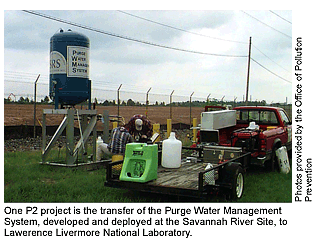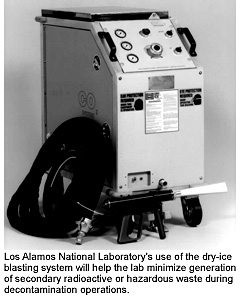|

 Stemming
the tide of newly generated waste Stemming
the tide of newly generated waste
OS’s traditional focus has been on technologies for addressing
legacy waste and contaminated soil and groundwater resulting from
past environmental practices. But, more recently, OST has been discovering
that its technologies also have a role to play in lowering the volume
of newly generated waste. In collaboration with DOE’s
Office of Pollution Prevention (OPP), OST has initiated 12 projects
that exemplify how OST technologies are being applied to pollution
prevention (P2)—the elimination or reduction in the generation
or release of pollutants, contaminants, hazardous substances, and
wastes to the environment.
2001 P2 projects
- TRU Waste Retrieval Mobile Assay System (Hanford Site)
- Technology Transfer of Waste-Reducing Groundwater Sampling
Systems (Lawrence Livermore National Laboratory)
- Dry Ice (CO2) Blasting for Large Item Decontamination Operations
(Los Alamos National Laboratory)
- Solidification as a Replacement for Incineration of TRU
Oils, Organics, etc. (Miamisburg Environmental Management
Project)
- Field Demonstration of Multiple Permeable Reactive Barriers
(Los Alamos National Laboratory)
- Construction and Demolition Concrete Recycling Facility
(Los Alamos National Laboratory)
- In Situ Redox Manipulation (ISRM) at the 100D Area (Hanford
Site)
- In Situ Natural Biodegration of Highly Explosive Contaminated
Soil (Pantex Plant)
- Contaminated Large Equipment Program (CLE) (Savannah River
Site)
- Canyon Disposition Initiative (Hanford Site)
- HLW Diversion Box Valving Modifications (Savannah River
Site)
- Polyurea Spray Equipment (Savannah River Site)
|
In early 1999, OPP asked field sites to propose pollution prevention
projects with potential to reap high returns on investment (ROI).
After observing that many of the proposed projects could be linked
to OST-developed technologies, OPP and OST decided to work together
to select some projects for deployment. Life-cycle savings for the
12 selected projects are estimated at $105 million.
One of the selected P2 projects, Technology Transfer of Waste-Reducing
Groundwater Sampling Systems (Lawrence
Livermore National Laboratory), is a technology transfer initiative
with an ROI of 32%. This project involves deploying the Savannah River
Site-developed Purge Water Management System (PWMS) at LLNL. The patented
PWMS is a closed-loop, noncontact system used to return purge water
to the originating aquifer after a sampling event without significantly
altering water quality (see Initiatives,
Spring 2001).

Another P2 project, TRU Waste Retrieval Mobile Assay System (Hanford
Site), boasts an ROI of 170%. This mobile assaying equipment conducts
characterization activities in a mobile unit at retrievable storage
locations, thus avoiding the need to transport the containers to the
Waste Receiving and Processing Facility. This approach will allow
those containers that assay as low-level waste to be returned directly
to the burial grounds for permanent disposal at minimum expense. Waste
handling costs are significantly reduced and hazards associated with
processing minimized.

Finding other ways to collaborate
In July 2000, the Ohio Field Office
and the Savannah River Site initiated
a pilot program to explore the benefits of collaboration between the
OST and P2 programs in the field. The sites are finding that such
collaborations can facilitate deployment of OST technologies and implementation
of projects for reducing waste. Since then, similar collaborative
efforts have been started at the Chicago
and Oak Ridge Operations Offices.
OPP expert teams conduct assessments, recently with support from
OST, to identify cost-effective options for addressing site problems.
And field offices have started using the P2 ROI calculation approach
to quantify technology benefits in support of future OST demonstration
projects. These collaborative efforts, and others that are being discussed,
have come about as the OST and P2 programs have come to the understanding
that greater use of new technologies for promoting waste reduction
can contribute to a broad range of Environmental Management mission
activities.
For more information on OST’s collaboration with the P2 program,
contact John Lum at (301) 903-1384,
john.lum@em.doe.gov, or Stan Wolf at (301) 903-7962, stanley.wolf@em.
doe.gov.
|

 Stemming
the tide of newly generated waste
Stemming
the tide of newly generated waste
